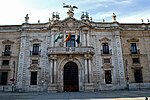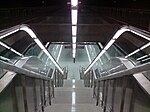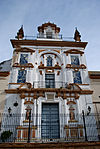Palacio de San Telmo
Baroque architecture in SevilleBien de Interés Cultural landmarks in the Province of SevilleBuildings and structures completed in 1895Government buildings in SpainOfficial residences of subnational executives ... and 2 more
Palaces in SevilleSchool buildings completed in 1754

The Palace of San Telmo (Spanish: Palacio de San Telmo) is a historical edifice in Seville, southern Spain, formerly the Universidad de Mareantes (a university for navigators), now is the seat of the presidency of the Andalusian Autonomous Government. Construction of the building began in 1682 outside the walls of the city, on property belonging to the Tribunal of the Holy Office, the institution responsible for the Spanish Inquisition. It was originally constructed as the seat of the University of Navigators (Universidad de Mareantes), a school to educate orphaned children and train them as sailors.
Excerpt from the Wikipedia article Palacio de San Telmo (License: CC BY-SA 3.0, Authors, Images).Palacio de San Telmo
Avenida de Roma, Seville Casco Antiguo
Geographical coordinates (GPS) Address External links Nearby Places Show on map
Geographical coordinates (GPS)
| Latitude | Longitude |
|---|---|
| N 37.38015 ° | E -5.9937333333333 ° |
Address
Palacio de San Telmo
Avenida de Roma
41004 Seville, Casco Antiguo
Andalusia, Spain
Open on Google Maps











